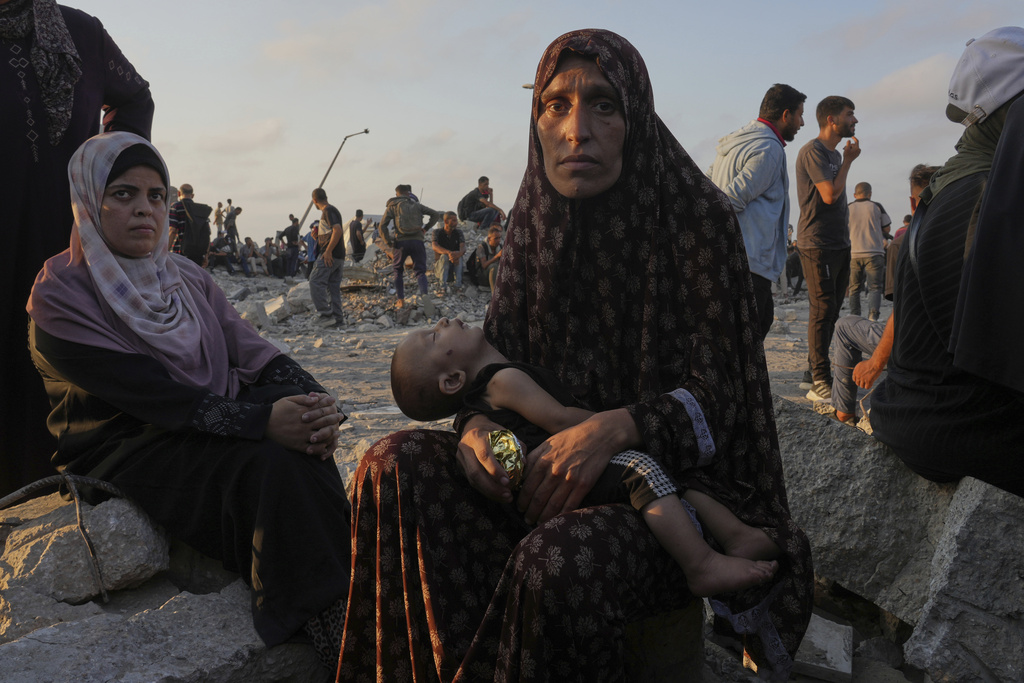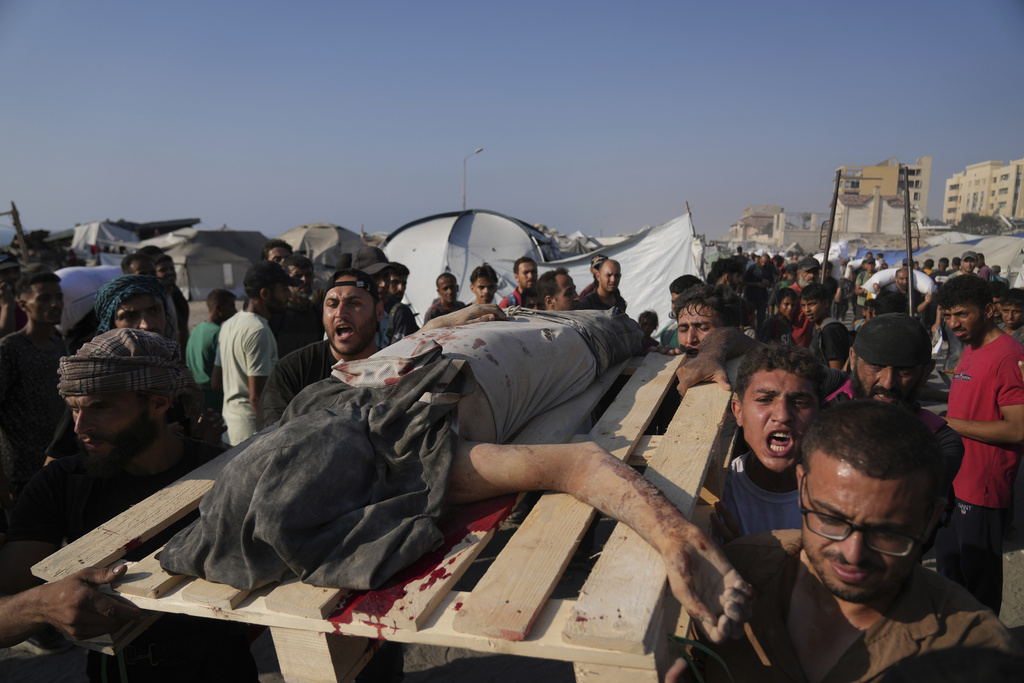Netanyahu Denies Starvation as Gaza Deaths Rise \ Newslooks \ Washington DC \ Mary Sidiqi \ Evening Edition \ Israeli Prime Minister Netanyahu denies starvation in Gaza, but humanitarian groups report rising malnutrition deaths. Trump contradicts Netanyahu, citing emaciated children as proof of a worsening crisis. U.N. and aid workers say Israel’s limited aid access and distribution issues are fueling hunger.

Quick Looks
- Netanyahu claims no starvation in Gaza; aid is flowing.
- Trump disagrees, citing visible hunger among Palestinian children.
- Israel launched humanitarian pauses and airdrops under pressure.
- U.N. says the new measures are temporary and insufficient.
- Gaza’s Health Ministry reported 82 malnutrition-related deaths in July.
- WHO confirms rising child deaths and tripled acute malnutrition in northern Gaza.
- U.N. food convoys often looted or blocked by military restrictions.
- Experts warn airdrops are dangerous and can’t meet demand.
- Only 146 aid trucks per day have entered Gaza — far below the needed 500–600.
- U.N. says more than half of truck movement requests are denied.
- Hunger worsens as aid is blocked, swarmed, or destroyed.
Deep Look
As global concern mounts over the worsening humanitarian crisis in Gaza, a war of words is unfolding at the highest levels of leadership. Israeli Prime Minister Benjamin Netanyahu insists that “there is no starvation in Gaza,” asserting that his government has allowed consistent humanitarian aid to flow during the war. “Otherwise, there would be no Gazans,” he said, defending Israel’s current policies.
Former U.S. President Donald Trump publicly rebuked Netanyahu’s comments, pointing to disturbing images circulating globally of emaciated Palestinian children. “Those children look very hungry,” Trump said on Monday, directly challenging the Israeli leader’s assertion and aligning himself with growing international concern.
The U.N. and major humanitarian organizations tell a different story — one of spiraling malnutrition, blockades, and worsening conditions on the ground. Despite Israel’s announcement over the weekend of temporary humanitarian pauses, limited airdrops, and designated hours for aid delivery in parts of Gaza, aid groups and residents say these gestures have produced minimal change.
Malnutrition-Related Deaths Rising Sharply
The World Health Organization (WHO) reported a staggering 63 malnutrition-related deaths in Gaza this month alone, including 24 children under the age of five. That number is nearly six times higher than all malnutrition-related deaths reported in the previous six months combined. Gaza’s Health Ministry, considered a reliable source by the U.N., reported even higher figures — 82 deaths in July, including 58 adults and 24 children. It noted 14 deaths in just the last 24 hours.
At the Patient’s Friends Hospital, the main treatment center for malnourished children in northern Gaza, doctors say they are now seeing young patients with no prior health conditions die from starvation for the first time. Among adults, existing conditions such as diabetes, heart disease, and kidney failure have been exacerbated by the lack of food and medicine.
Acute malnutrition in children under five has tripled in northern Gaza this month, according to the WHO, now affecting nearly 20% of children in that age group. Central and southern regions have seen malnutrition rates double. The U.N. says Gaza’s only four clinics specializing in malnutrition treatment are “overwhelmed.”
Despite months of warnings from the Integrated Food Security Phase Classification — the global authority on famine risk — a formal famine declaration has not been made. Officials cite lack of access to reliable data due to Israeli restrictions on international observers entering Gaza.
Aid Blocked, Swarmed, and Insufficient
The humanitarian pause announced by Israel includes 10-hour daily windows in three high-density areas, theoretically allowing safer food distribution. But implementation has been chaotic. The U.N. World Food Program (WFP) confirmed that 55 of its aid trucks entering Gaza on Monday via the Zikim and Kerem Shalom crossings were looted by desperate, starving civilians before they could reach WFP-controlled storage centers.
“Trucks never even reached the warehouse,” said WFP spokesperson Martin Penner.
Israel has also conducted airdrops of food packages — 48 in total between Sunday and Monday — but aid organizations and local Palestinians say these are symbolic and often dangerous. Witnesses report civilians scrambling for food mid-air or being injured by falling crates.
The Palestinian population and many aid groups continue to call for a return to the pre-war U.N.-led distribution system. Since May, Israel has implemented its own approval-based system, which Palestinians say has led to delays and violence. There are repeated reports of Israeli forces opening fire on hungry crowds gathering near aid distribution points, leading to hundreds of injuries and deaths. Israel says it has fired warning shots to deter what it views as potential threats.
Meanwhile, the numbers reveal a severe shortfall in aid: Israel reports that 95,435 aid trucks have entered Gaza since the war began — an average of 146 per day. That figure falls far short of the 500–600 trucks per day that the U.N. considers the minimum to sustain Gaza’s 2.3 million residents. During parts of the conflict, aid truck entries fell to half that number. For 2.5 months beginning in March, Israel enforced a total blockade — no food, fuel, or supplies entered at all.
Delivery Complicated by Red Tape and Violence
Even when aid does enter Gaza, the process is fraught with logistical challenges. Supplies are dropped at border points inside Gaza, but the U.N. must receive Israeli military clearance before dispatching its own trucks to retrieve and distribute them. In the past three months, the U.N. reports that more than 50% of its truck movement requests have been denied or delayed by Israeli authorities.
Once clearance is given, U.N. convoys must navigate through desperate civilians and armed gangs. Looting and hijacking of aid shipments have become increasingly common, especially since Israeli airstrikes targeted the Hamas-run civilian police, which had previously provided some protection along humanitarian routes.
The humanitarian community overwhelmingly agrees: the most efficient and humane method of delivering aid remains truck-based distribution, not air or sea drops. A single truck can carry approximately 19 tons of supplies — far more than airdrops can match — and allows for more controlled, equitable distribution if access and security are guaranteed.
Calls for Accountability and Action
Aid agencies, U.N. officials, and former world leaders are increasingly vocal in calling for expanded, unrestricted humanitarian access. Trump’s unexpected comments have brought further attention to the crisis and could increase pressure on the Israeli government.
Meanwhile, voices from Gaza, like Hasan Al-Zalaan — a witness at one of the chaotic airdrops — reflect the frustration on the ground: “This aid, delivered in this way, is an insult to the Palestinian people.”
With rising child deaths, overwhelmed hospitals, and malnutrition reaching alarming levels, the international community faces mounting pressure to broker a sustainable humanitarian solution. Whether Netanyahu’s government changes its course or further restricts access remains to be seen — but time, according to experts and frontline responders, is running out for Gaza’s most vulnerable.
Netanyahu Denies Netanyahu Denies Netanyahu Denies







